Google Nexus 4 Review - Google's new Flagship
by Brian Klug on November 13, 2012 8:45 AM EST- Posted in
- Smartphones
- LG
- Android
- Mobile
- APQ8064
- Nexus 4
- Android 4.2
- MDM9215
The Nexus 4 is based around a 1.5 GHz Qualcomm Snapdragon S4 Pro SoC, the quad core Krait APQ8064 with Adreno 320 GPU, which is still built on a 28nm process. The combination of APQ8064 for AP and MDM9x15 for baseband is Qualcomm's Fusion 3 platform, and the Nexus 4 and Optimus G are the first phones to market based on that platform. This is a relatively unique opportunity for Nexus, which until recently wasn't really first to market with the latest and greatest silicon.
A while ago we posted our Nexus 4 and Nexus 10 performance preview. At that point we still had a lot of testing to perform, and many people noted that the Nexus 4 performance was far behind the LG Optimus G despite it being based on the same platform. Later, some people noticed that I had uploaded another set of results from GLBenchmark 2.5 to the online result browser with much better performance. The difference wasn't some over the air software update but rather that I was running some of the tests with the Nexus 4 in a ziplock bag inside the freezer to mitigate any condensation problems, and simultaneously nail down any possible thermal throttling.
I've re-run everything and can confirm obviously that there was thermal throttling going on affecting some of the results, and have included the new results wherever there was a deviation from previous. For those wondering why the LG Optimus G wasn't affected in spite of it having the same platform, the reason is because the results from the Optimus G were run in parts due to some instability affecting its ability to run a complete set of tests without crashing. The Nexus 4 has newer drivers that don't crash during a full GLBenchmark 2.5 run but as a result run the device long enough for thermal throttling to kick in.
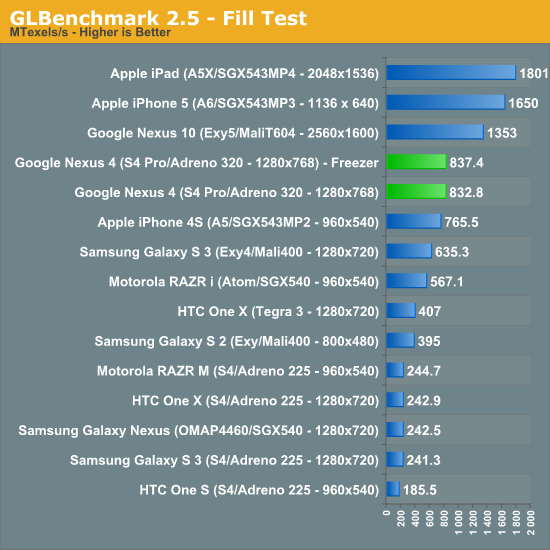
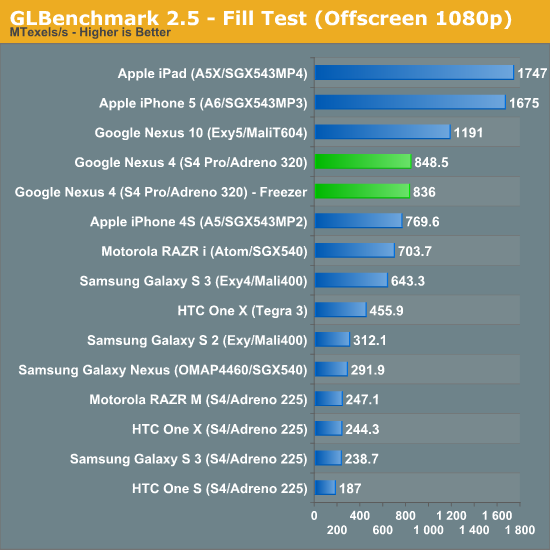
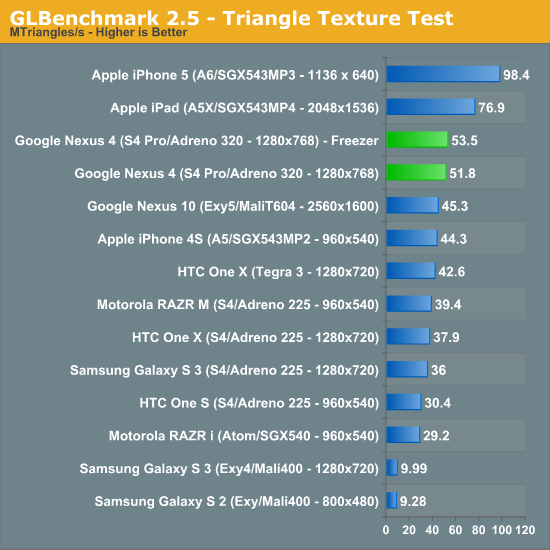
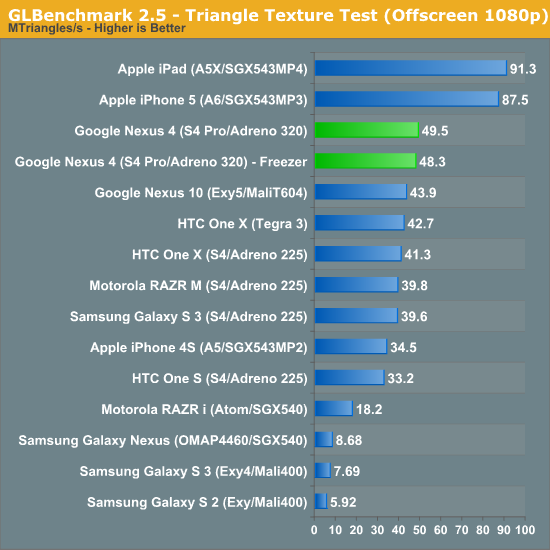
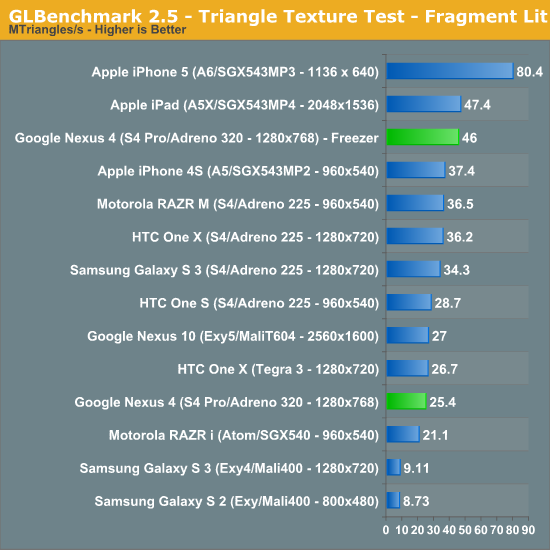
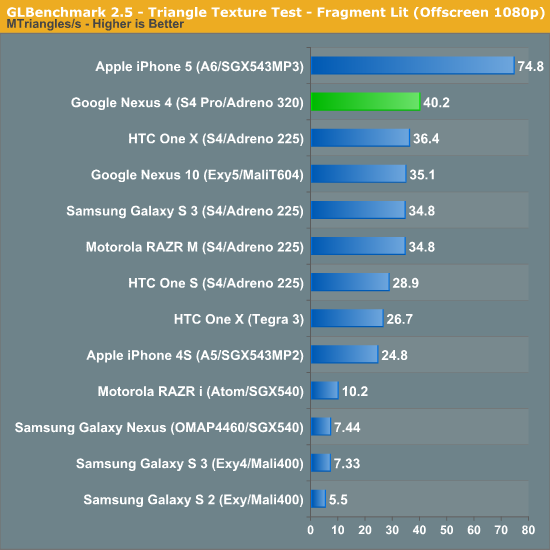
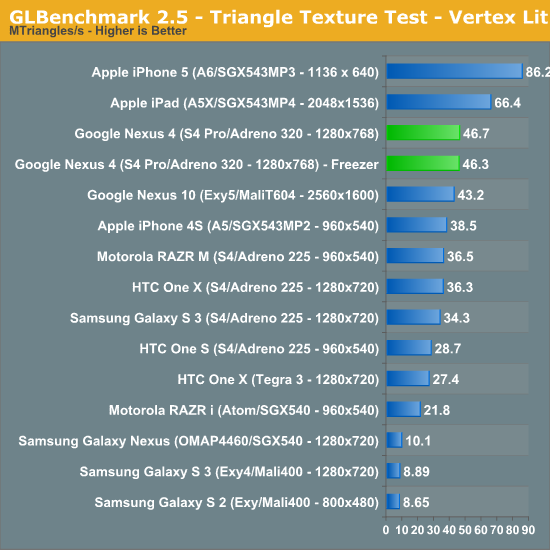
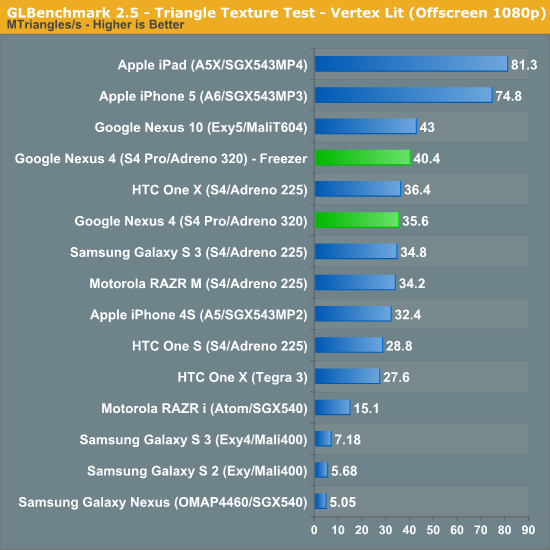
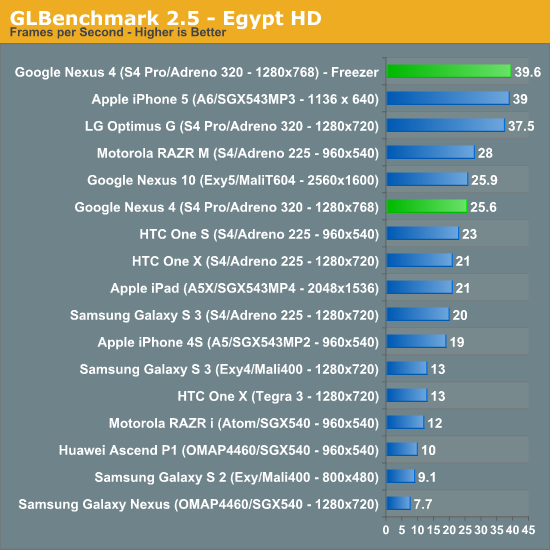
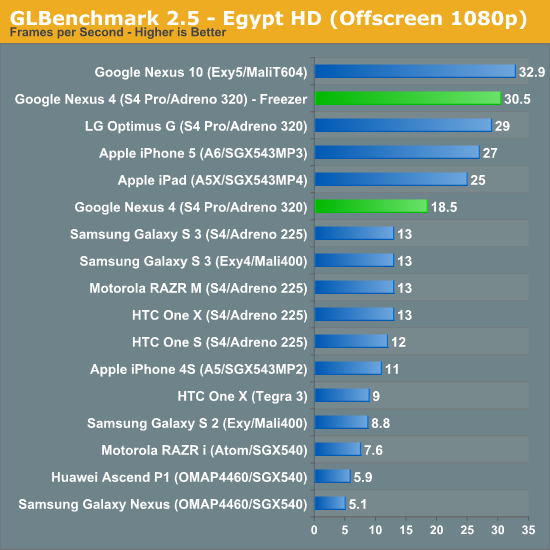
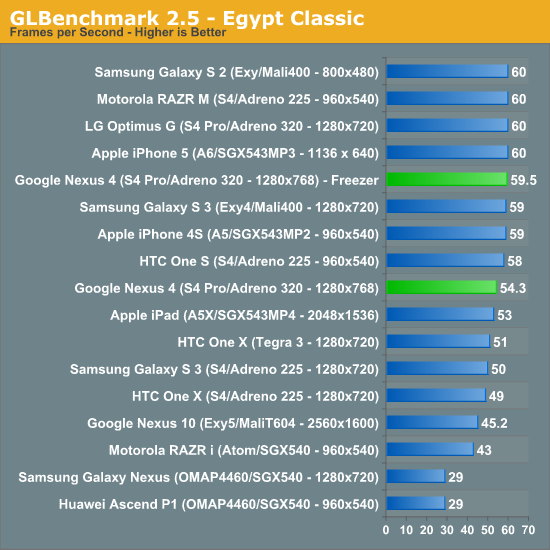
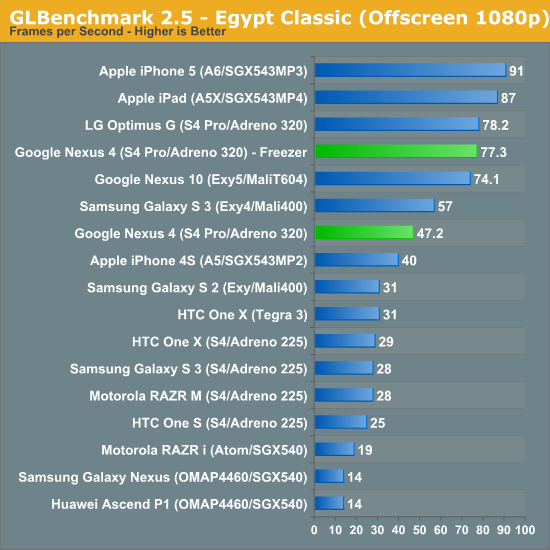
The result of the tests in the freezer results that are much closer to what we'd expect based on the APQ8064 MDP/T runs and the Optimus G numbers I saw in Korea.
When it comes to the CPU side of things there were results also affected by thermal throttling. I spaced some of those runs out (unintentionally) enough that performance didn't change, but for other things it did affect performance. I can't tell what GPU clocks end up being when the SoC decides to throttle, but it is possible to nail down what CPU performance state APQ8064 settles down into when there's throttling going on by looking at the state tables.

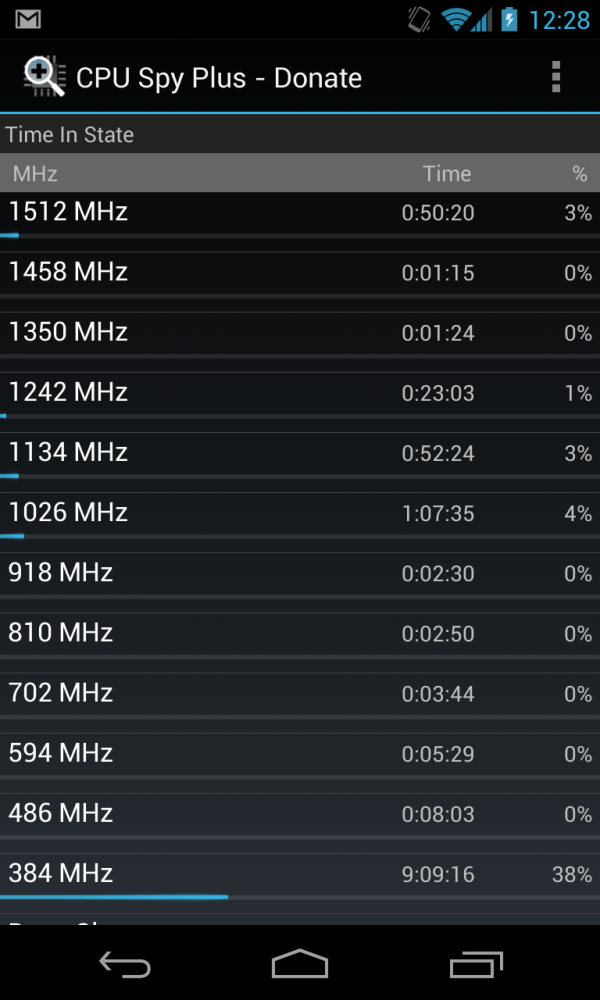
Left - 1.134 GHz during throttling (running tests), Right - All the performance states
I can see the Nexus 4 not use any of the performance states above 1134 MHz when it's getting hot, as shown in the images above. I've tweeted a link to the pastebin for thermald.conf which I believe configures the thermal cutoffs and will be interesting to kernel hackers trying to play with these values.
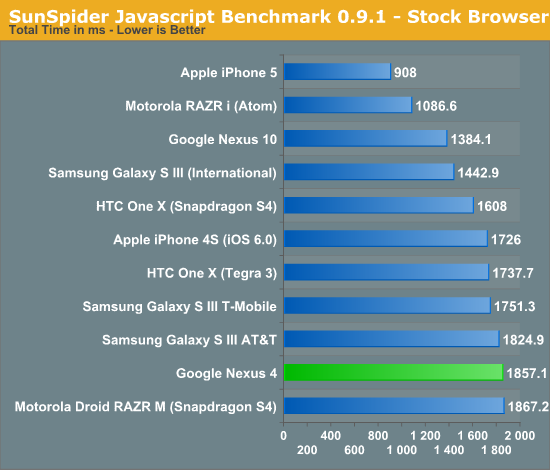
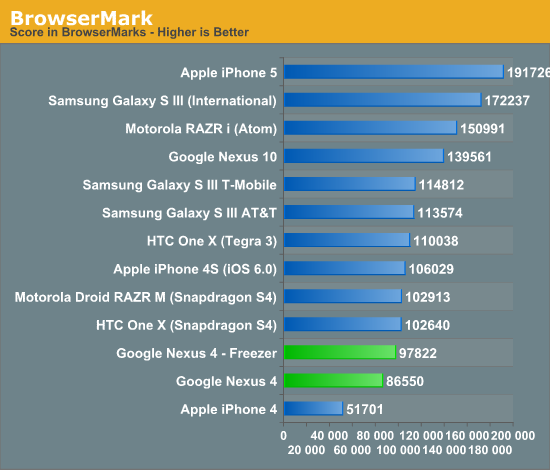
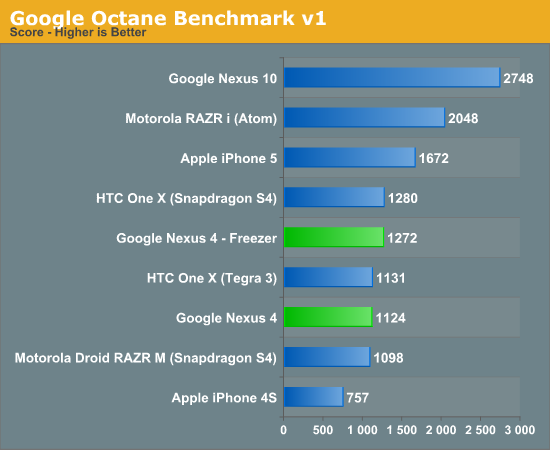
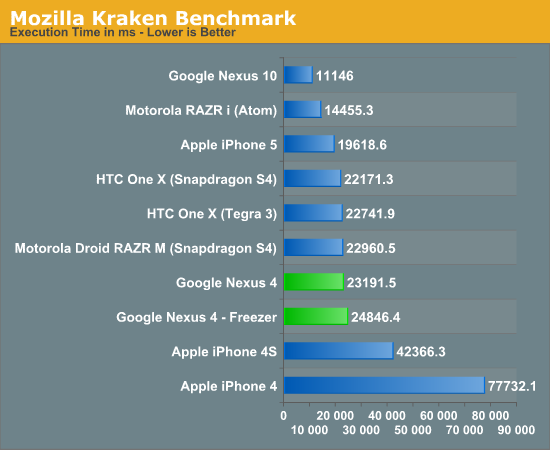
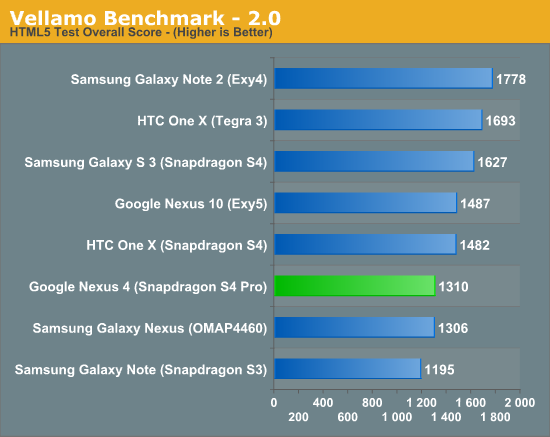
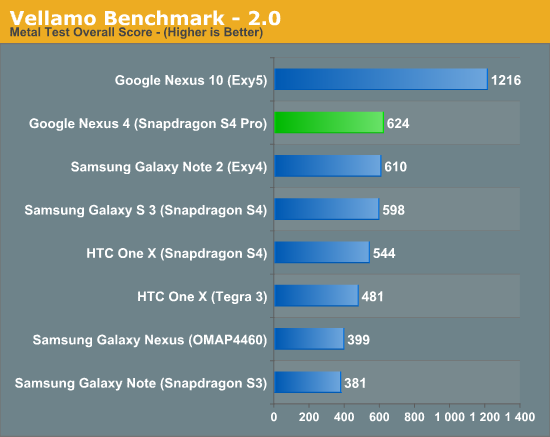
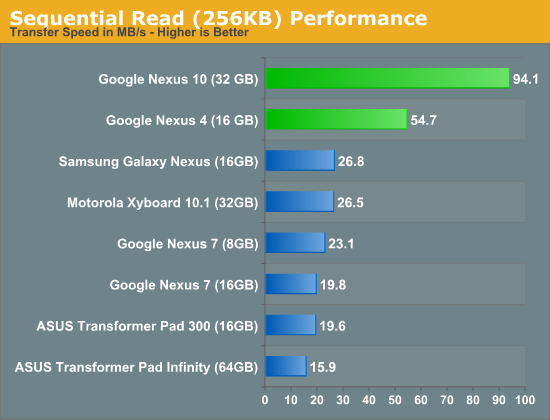
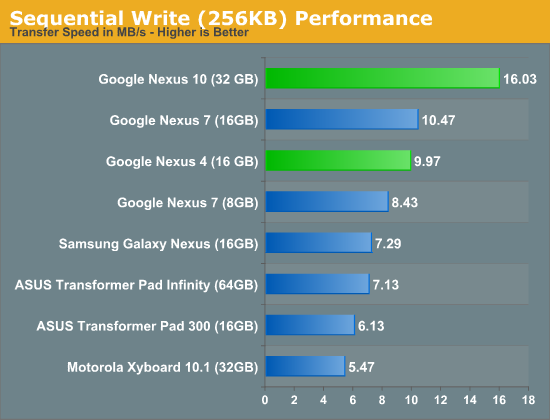
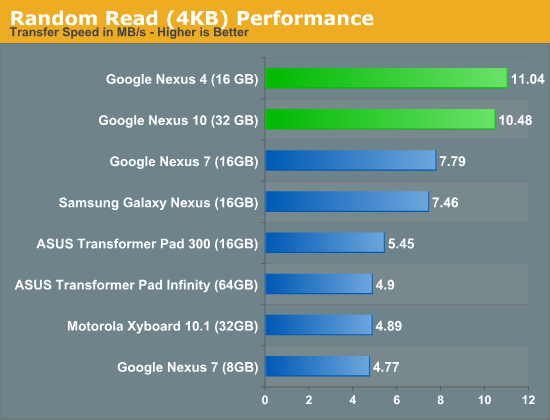
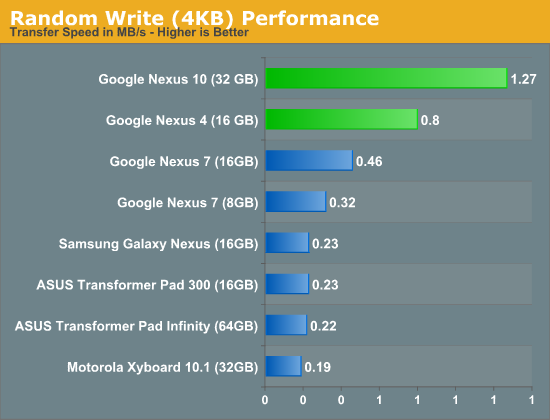
Our CPU performance side is unfortunately still dominated by JavaScript performance tests. The story there is that the Nexus 4 ships with Chrome (and originally shipped with a newer build of Chrome than what was on the market - we were running that updated version all along) and thus the mainline version of the V8 JavaScript engine. OEMs perform their own optimizations to the V8 library, and try to upstream whatever they can into the main project, but in the case of Chrome for Android that means V8 sans secret OEM sauce.










188 Comments
View All Comments
Rits - Tuesday, November 13, 2012 - link
Mean nothing in real life. The N4 flies through tasks in practical usage. Bring me an iPhone5 and show me how it is faster in any way. Synthetic benchmarks are, for the most part, useless. Esp, cross-platform ones.PeteH - Tuesday, November 13, 2012 - link
Depends. In most cases I agree with you, but if you're interested in a phone capable of, for example, playing state of the art (for a mobile device) games, certain graphical benchmarks are useful.Granted most users won't care about that, but most users don't read AnandTech.
lilmoe - Wednesday, November 14, 2012 - link
The iPhone 5 isn't faster, its software is more optimized. Chrome is well known to really "suck" in javascript and scrolling performance on Android. Even Dolphin Browser beats it in each performance category. Samsung's stock browser on the SGS3 is probably the best Android browser out there, I wonder how well it would perform on the Nexus 4's CPU. Chrome is nice for syncing bookmarks across all your devices in addition to some stuff, but otherwise, it really sucks.In the GPU benchmark tests where the A6 (PowerVR SGX543 MP3) beats the APQ 8064 (Snapdragon S4 Pro's Adreno 320), These are sub-scores (sub-tests) that don't really show the "big picture". They test the GPU of the platform for several shader-centric tasks. Those who use these benchmarks are looking for specific numbers for specific purposes.
What really matters in GLBenchmark for most consumers is the "Egypt Classic" and "Egypt HD" tests. These tests show the gaming/GPU performance of the platform as a whole, with the former testing "generic" 3D gaming capabilities, and the latter testing for the most modern demanding games (that stresses the platform/shaders for most fillrate, vertex, and compute performance. It's mostly over-kill and you wont see games demanding the same anytime soon). You'll easily achieve 60fps with any game you run on the Nexus 4 even with a higher resolution than the iPhone 5...
The Nexus 4 should prove to be better performing and more "future-proof" than the iPhone 5, since it has a faster CPU (quad core Krait VS dual core Swift) and a GPU that supports future standards like OpenGL ES 3.0, Open CL and Renderscript, unlike the PowerVR inside the A6 chip. Software optimization is a non-issue since it can be tuned-up in future updates or different browsers from Play Store in the case of the web browser.
There are lots of metrics to consider in cross-platform/cross-OS benchmarking, and there's absolutely NO benchmark that will show the true difference of performance among different platforms, especially with "Android VS Android" or "Android VS iOS" because each Android OEM utilizes different hardware and different software optimizations (in addition to other factors, like thermal throttling in this review's case). That's probably not the case when comparing the iPhone 5 versus the 4S or even a Windows Phone 8 devices versus another device running the same OS because both platforms use vertically integrated hardware/software, but that's where firmware and driver version differences start to kick in, but it's closer to reality than anything related to Android.
Red Oak - Tuesday, November 13, 2012 - link
And also, no LTE. Comical. Certainly for the US marketantef - Tuesday, November 13, 2012 - link
Not at half the price of other phones. Also Android and especially Nexus is an open platform, so that automatically shuts the door on CDMA and consequently the biggest LTE carrier in the US. Nobody who has good HSPA+ cares.Penti - Tuesday, November 13, 2012 - link
In Europe you get pretty good carrier support with just quad band LTE which is showing up now. All USIM, plus Band 7, Band 20, Band 8, Band 3 covers most here and is available in most countries. In Sweden we started on Band 7 and now runs networks at Band 20 and Band 8 too. So we can actually get devices now which runs on all the frequencies either in use or that will be refarmed. Similar in other countries here. Most carriers has a few bands. You do need to support more then one. More troublesome in the US obviously. It is looking up finally though. DC-HSPA+ is up an running too so, even in small communities. It's not bad, at least not if you are able to use wifi for heavier/larger stuff.antef - Tuesday, November 13, 2012 - link
Clearly the Nexus 4 is not named as such because it's the 4th Nexus phone like you mention. If that was the case the Nexus 7 and 10 would throw a wrench in that wouldn't it? It's named that way because the screen is 4(.7)". If you look at the Nexus logo on the site they even de-emphasize the number by making it a small superscript to "nexus" and saying "now in three sizes." The fact that it's the 4th Nexus is just a coincidence. I would expect them to keep these names going forward and just release a Nexus 4 2nd gen, 3rd gen, etc.Rits - Tuesday, November 13, 2012 - link
Correct.tarunactivity - Tuesday, November 13, 2012 - link
The iPhone 5 resolution is 1136x640-pixel , not 1136x960 ...http://www.apple.com/iphone/specs.html
stotticus - Tuesday, November 13, 2012 - link
Of what city are those pictures?